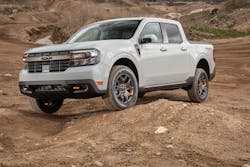Ford Blue President: Don't Write Off ICE
In 2022, Ford Motor Co.’s automotive business was divided into two groups: Model E, the electric vehicle side, and Ford Blue, the legacy internal combustion engine and hybrid vehicle side. Kumar Galhotra, Ford’s then-North American president—a leader known for finding and implementing operational efficiencies that increased profitability—was named president of Ford Blue.
Galhotra spoke at the Automotive News Congress on Wednesday about the viability of the internal combustion engine (his take: it’s still got plenty of life left), and how Ford Blue can become more efficient and better anticipate supply chain challenges.
On ICE Engines:
“Propulsion isn’t going to be as binary as folks thought. Even two, three years ago, it was going to be either internal combustion or pure BEVs. We think there’s going to be quite a bit in the middle. At least for us. Full hybrids are gonna play a big role, but even things like range extenders. There’s going to be a whole continuum. And from the Ford Blue perspective, we are investing in all of those categories.”In the Chinese market, the continuum is already in play, Galhotra says. “It’s shocking how many different propulsion systems there are between pure ICE and pure BEV.” The continuum will be necessary to balance compliance with being profitable.
Galhotra notes that Ford is No. 3, behind Toyota and Honda, in hybrid sales. As demand for the hybrid Maverick truck in 2023 has outpaced production, Ford recently added a third shift to the Maverick plant in Hermosillo, Mexico. “We are actually building on the third shift, and there’s still not enough vehicles.”
On Reducing Complexity:
The latest iterations of the F-150 had many thousands of buildable combinations—some combinations they only built for one vehicle per year—but with the latest F-150, “we’re going to go down to a few hundred,” he said. “There was always this internal tension of the marketing team wanting to always have the opportunity to be able to provide precisely what the customer might want when they walk into the dealership. Given the kind of product we make, those opportunities are endless … So we got rid of all of those, and have gotten it down for all of our vehicles now to double digit kind of numbers for complexity.”
Cutting down on combinations also cut down on the number of required parts. “If you have fewer parts, then you have fewer parts to test. So it’s better for quality, it’s better for cycle time, it’s better for line space.
“We used to have hundreds of wire harnesses [one for each specific combination of electrical components] sitting next to the Explorer assembly line. You can’t put them all there because there’s not enough space, so you end up sequencing. A lot of suppliers know what that means: you literally build the wire harnesses in sequence, you ship them in sequence, then you bring them to the line in sequence and you put them on the vehicle in sequence. And if you mess up one of those, then your sequences are all messed up.” Now, Explorer assemblers are down to nine main harnesses that they can stack next to the line.
On Supplier Relationships:
Ford has made communication with Tier 2 and 3 suppliers a new priority since the pandemic and the semiconductor crisis, to better understand and anticipate challenges around production and inventory. “Traditionally, our primary relationship and interaction has been with Tier 1s on the critical commodities,” Galhotra said. Now we’ve gone deeper, where we’re creating relationships with a lot of Tier 2s, and sometimes even Tier 3s.” It’s part of their risk management on key commodities now.
“Semiconductors for us as well as everybody else are in a much better place than it was just three or four quarters ago,” he said. “We’re still struggling with some other commodities. Anything that is a difficult-to-build job, like welding, casting, forging—suppliers, they struggle to keep that labor. And that causes disruptions. We’re coming up with strategies on how to make sure that those commodities are available.”
About the Author

Laura Putre
Senior Editor, IndustryWeek
As senior editor, Laura Putre works with IndustryWeek's editorial contributors and reports on leadership and the automotive industry as they relate to manufacturing. She joined IndustryWeek in 2015 as a staff writer covering workforce issues.
Prior to IndustryWeek, Laura reported on the healthcare industry and covered local news. She was the editor of the Chicago Journal and a staff writer for Cleveland Scene. Her national bylines include The Guardian, Slate, Pacific-Standard and The Root.
Laura was a National Press Foundation fellow in 2022.
Got a story idea? Reach out to Laura at [email protected]

